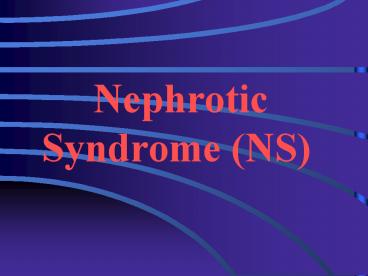Nephrotic Syndrome (NS) - PowerPoint PPT Presentation
1 / 50
Title:
Nephrotic Syndrome (NS)
Description:
Nephrotic Syndrome (NS) 2.Hypoproteinemia (mainly albumin) 3.Edema: Nephrotic edema (pitting edema) Laboratory Exam 1.Urinary protein: 2+ 4+ 24hr ... – PowerPoint PPT presentation
Number of Views:1205
Avg rating:3.0/5.0
Title: Nephrotic Syndrome (NS)
1
Nephrotic Syndrome (NS)
2
Definition NS is an
accumulation of symptoms and signs and is
characterized by proteinuria, hypoproteinemia,
edema, and hyperlipidemia.
3
The vast majority patients (90 of cases) with
NS of childhood are primary.
In children under age 5 years the
disease usually takes the form of idiopathic
(primary) NS of childhood (nil disease, lipoid
Nephrosis).
4
Conditions Of Attack Second only to
acute nephri-tis. Incidence age At all
ages, but most commonly between 25 years of age.
5
Type 1.Clinical type
Simple NS Nephritic NS 2.Response to steroid
therapy (P331)
6
The initial response to cortico- steroids is
a guide to prognosis. (1) Total effect
(2) Partial effect (3) Non-effect
7
3. Pathologic type (P328) Minimal change
disease, MCD 80 of patients.
8
Pathogenesis The primary
disorder is an increase in glomerular permea-
bility to plasma proteins. ?Foot processes of
the visceral epithelium of the GBM.
9
1.The construction of theglomerular
basement memb-rane has changed. 2.The loss
of the negative charges
on the GBM.
10
?The underlying pathoge-nesis is
unknown, but evidence strongly supports the
impor- tance of immune mechanisms(P328).
11
Pathophysiology
1.Proteinuria Fundamental and highly important
change of pathophysiology.
12
2.Hypoproteinemia (mainly albumin)
3.Edema Nephrotic edema (pitting edema)
13
Hypoproteinemia plasma
oncotic pressure is diminished,
result in a shift of fluid from the vascular to
the interstitial compartment and plasma
14
volume??the activation of
the reninangiotensinaldo-sterone
system? tubularsodium chloride reabsorp-tion?.
15
4. Hyperlipidemia (Hyper-cholesterolemia)
Ch?, TG?, LDL-ch?,VLDL-ch?.
16
Clinical Manifestations There is a
male preponderance of 21. 1.Main
manifestations Edema (varying degrees) is the
common symptom.
17
Periorbital swelling and perhaps
oliguria are noticed??increasing
edema??anasarca evident.
18
2.General symptoms
Pallid, anorexia, fatigue,abdominal
pain, diarrhea.
19
Laboratory Exam 1.Urinary protein
24 24hr total urinary protein gt
0.1g/kg. ( The most are selective
proteinuria. )
20
May occur granular and red cell casts.
2.Total serum protein?,lt30g/L . Albumin
levels are low (lt20g/L).
21
3.Serum cholesterol and triglycerides
Cholesterol gt5.7mmol/L (220mg/dl). 4.
ESR?gt100mm/hr.
22
5.Serum proteins electro-phoresis
Albumin?, a2-G?,?-G?, A/G inversion.
23
6.Serum complemen Vary with clinical type.
7.Renal function
24
Complications 1.Infections
Infections is a major compli-cation in children
with NS. Itfrequently trigger relapses.
25
Site Respiratory tract, skin, urinary tract
and acute pri-mary peritonitis.
26
Causes Immunity lower , severe
edema?malcirculation, protein malnutrition, and
use hormone and immunosuppre-ssive agents.
27
2.Electrolyte disturbances (1) Hyponatremia
(2) Hypokalemia (3) Hypocalcemia
28
3.Thromboembolic phenomena (
Hypercoagulability ) Renal vein thrombosis
4.Hypovolemic shook 5.Acute renal failure
(prerenal)
29
Diagnosis 1.Diagnostic standard
(P330) ?Four characteristics. ?Excluding other
renal disease (second nephrosis).
30
2.Clinical type Simple NS or Nephritic NS.
Treatment
1.General measures 1.1 Rest
31
1.2 Diet Hypertension and edema Low
salt diet (lt2gNa/ day) or salt-free diet.
Severe edema Restricting fluid intake.
32
Increase proteins properly 2g/(kgday)
While undergoing the corti-costeroid
treatment Give VitD 5001000iu/day (or
Rocaltrol)and calcium.
33
1.3 Prevent infection 1.4 Diuretics Not
requires diuretics usually.HCT 25mg/(kg
day)Antisterone 35mg/(kg day)Triamterene
34
Attention Volume depletion, disorder of
electrolyte and embolism.
35
Apparent edema Give low molecular
dextran 1015ml/(kgtime)Dopamine
23ug/(kgmin) and/or Regitine 10mg Lasix
12mg/kg.
36
2.Corticosteroid therapy Short-course
therapy Prednisone 2mg/(kgday) or
60mg/m2/day (Max.60mg/day) in 3 or 4 divided
doses for 4wk?maintenance treatment
37
Prednisone 1.5mg/kg, single dose for
every-other day4wk.
?Total course of therapy 8 wk.
38
Middle-course long-course therapy ?
Induction of remission Prednisone 1.52mg/(kg
day)(Max.60mg/day) for 4wk untilthe urinary
protein falls totrace or negative levels ?
39
?After maintenance treatment Prednisone
2mg/kg , single dose for every-other-day4wk
tapered gradually (2.55mg/2wk)
discontinued.
40
?Total course of treatment ?Middle 6mo
?Long 912mo Estimate of curative effect
(P331).
41
3. Treatment of relapse and recurrence 3.1
Extend the course of corti- costeroid 3.2
Immunosuppressive agents(Cytotoxic agents)
42
? CTX (Cytoxan) 2mg/(kgday) for 812wk .
Total amount 250mg/kg
Side effects nausea, vomiting,WBC?,
trichomadesis, hemo-rrhagic cystitis and the
damage of sexual glands.
43
? CB (Chlorambucil) 0.2mg/kg for 8wk .
Total amount 10mg/kg ? VCR Levamisole
44
4.Impulsive therapy (1) Methylprednisolone
(MP) 1530mg/kg(lt1g/day10GS 100 250ml,
iv drip (within 12hr) , 3 times/one course. If
45
necessary, give another 12 courses after
12wkprednisone 2mg/kg, qodtapered gradually.
46
(2) CTX 0.50.75mg/m2 NS/GS iv drip
(1hr), give liquid 2,000ml/(m2.d) . Every
one mo for 68 times.
47
(3) CsA 57mg/kg, in 3 divided doses for
36mo. ?expense and nephrotoxicity.
48
(4) Anticoagulants Heparin Persantin
5mg/(kgday)for6mo.
49
5.Alleviar proteinuria Angiotensin
converting en-zyme inhibitions (ACEI)
Captopril, Enalapril and
Benazepril.
50
Prognosis Most cases of
minimal change disease eventually remit
permanently.































